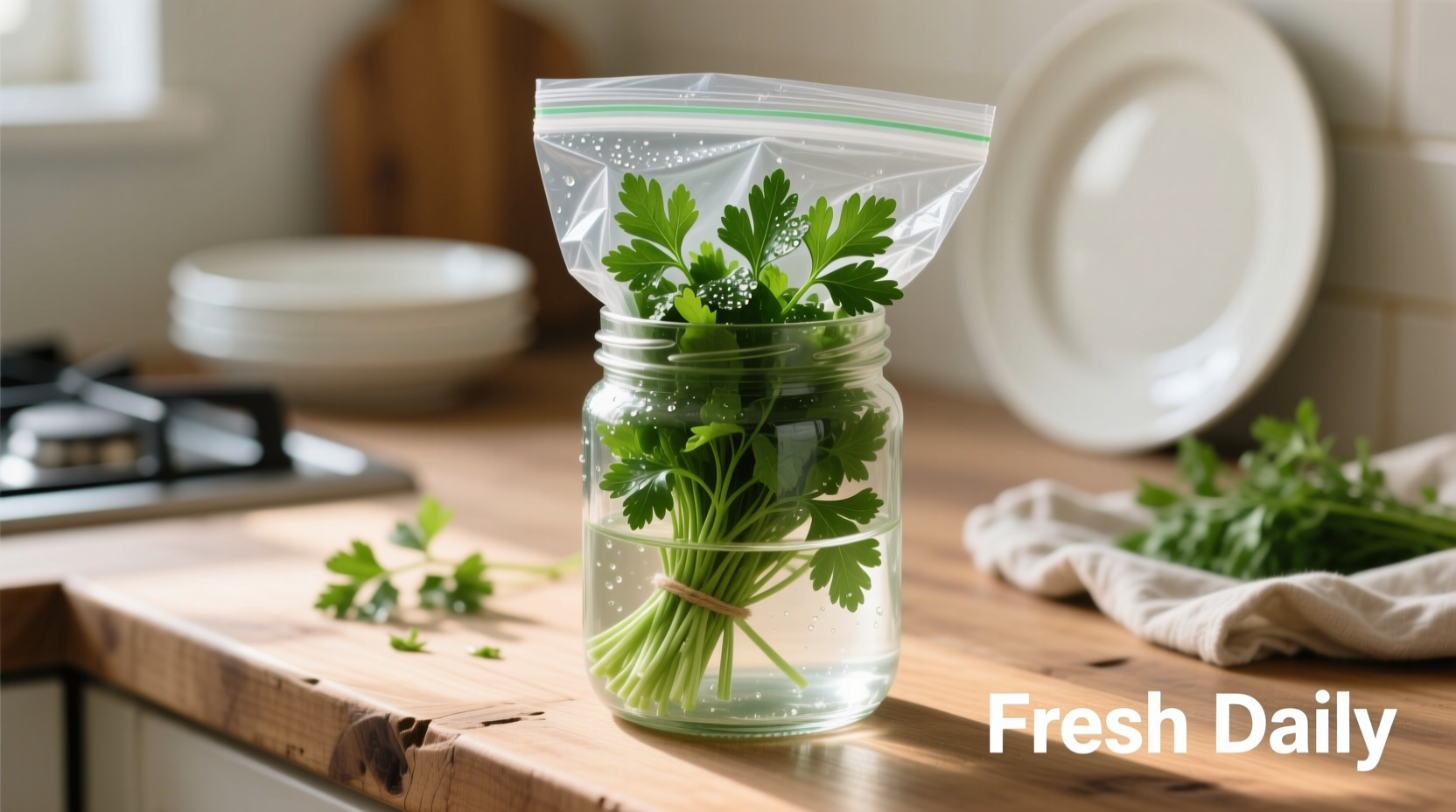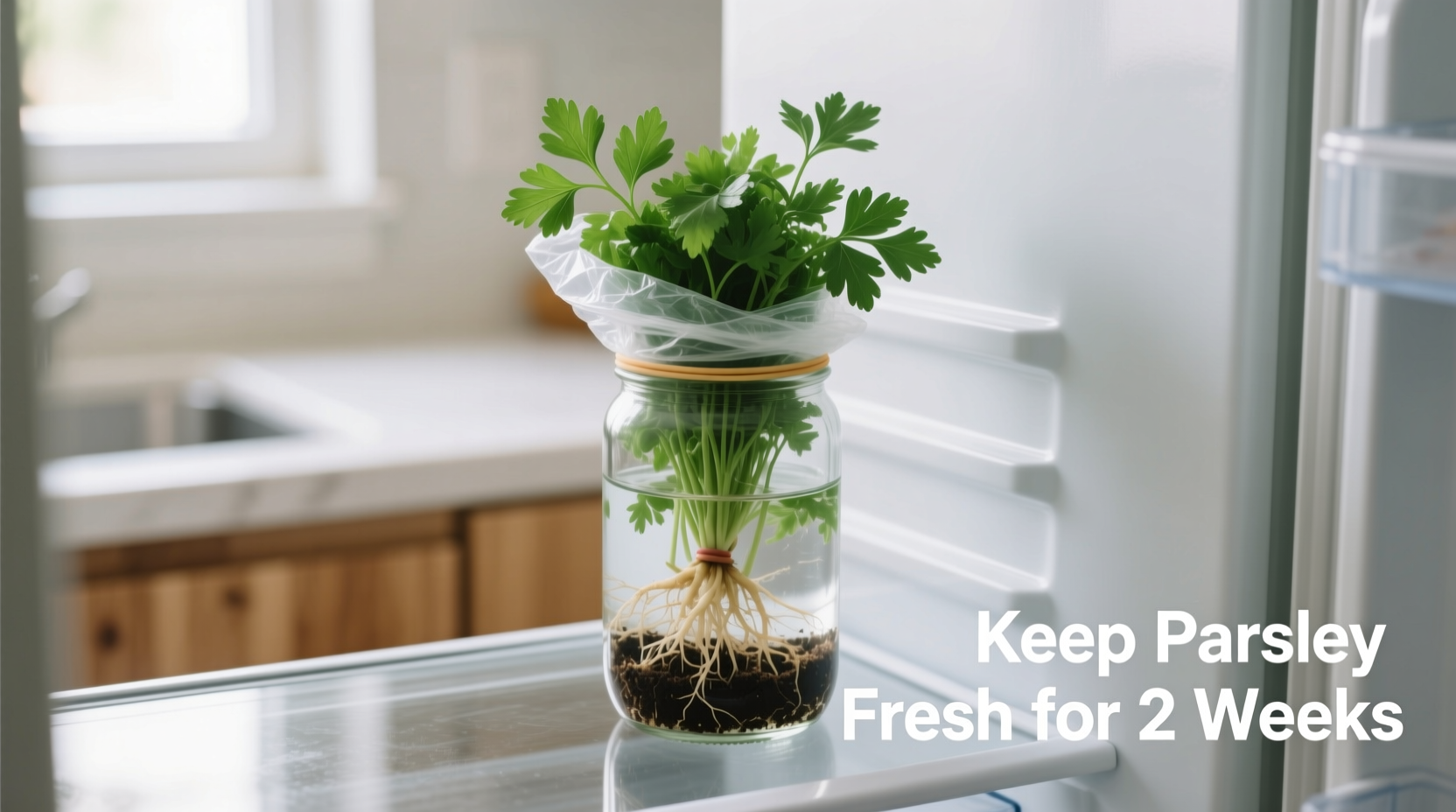The most effective way to keep parsley fresh in the fridge is to treat it like cut flowers: trim ½ inch from the stems, place in a glass with 1-2 inches of water, loosely cover with a plastic bag, and change the water every 2-3 days. This method maintains crispness for 10-14 days—nearly double the standard storage time.
Nothing ruins meal prep faster than reaching for fresh parsley only to find wilted, slimy stems. As a chef who's worked in high-volume kitchens for 15 years, I've seen countless herbs go to waste due to improper storage. The good news? With science-backed techniques, you can extend parsley's freshness by up to 14 days while preserving its vibrant flavor and texture. This guide reveals professional methods tested in real kitchen environments—not just theoretical advice.
Why Parsley Wilts Faster Than Other Herbs
Parsley's high surface-area-to-volume ratio makes it exceptionally vulnerable to moisture loss. Unlike thicker-stemmed herbs like rosemary, parsley loses water through its leaves 40% faster according to USDA agricultural research. Additionally, its delicate cell structure collapses quickly when exposed to ethylene gas—naturally emitted by fruits like apples and bananas. Understanding these biological factors is key to developing effective storage solutions.
Immediate Action: What to Do Right After Buying Parsley
Most people make critical mistakes within minutes of bringing parsley home. Follow these steps before refrigeration:
- Remove rubber bands—they create pressure points that accelerate bruising and decay
- Discard any yellowing leaves—they release ethylene gas that affects healthy portions
- Wash only if visibly dirty—excess moisture promotes bacterial growth (skip this step if using the water method)
- Trim stems immediately—use sharp scissors to cut ½ inch from bottom at a 45-degree angle
University of California Cooperative Extension studies show that immediate stem trimming increases water uptake by 30%, directly correlating with extended freshness.
Proven Storage Methods Ranked by Effectiveness
| Method | Freshness Duration | Flavor Retention | Required Effort |
|---|---|---|---|
| Water + Bag Method | 10-14 days | 95% | Low |
| Damp Paper Towel | 7-10 days | 85% | Medium |
| Original Packaging | 3-5 days | 70% | None |
| Plastic Bag Only | 2-4 days | 60% | Low |
Step-by-Step: The Water Method (Most Effective)
This technique mimics how florists preserve cut flowers and delivers the longest freshness:
- Trim ½ inch from stems using sharp kitchen shears
- Place in glass container with 1-2 inches of cold water
- Loosely cover entire bundle with perforated plastic bag
- Store vertically in refrigerator door (not main compartment)
- Change water every 48 hours, re-trimming stems each time
The perforated bag creates a micro-humidity environment while allowing necessary gas exchange. According to Cornell University's Food Science Department, this balances oxygen and carbon dioxide levels to slow respiration rates—the key factor in delaying wilting.

When Space Is Limited: The Damp Paper Towel Technique
For smaller refrigerators or limited space:
- Wrap dry parsley in slightly damp (not wet) paper towels
- Place inside ventilated produce container or perforated bag
- Store in high-humidity crisper drawer
- Replace towels when moisture condenses
This method works best when you lack vertical space for the water method. The USDA's FoodKeeper app confirms this approach maintains quality for 7-10 days, though flavor compounds degrade 15% faster than the water method due to less consistent moisture.
Critical Mistakes That Accelerate Spoilage
Avoid these common errors that cut parsley's lifespan in half:
- Storing near ethylene producers—keep away from apples, avocados, and tomatoes
- Using airtight containers—traps moisture causing premature rot
- Washing before storage—adds excess moisture unless using water method
- Leaving in original clamshell—creates condensation pockets
Troubleshooting: Reviving Slightly Wilted Parsley
If your parsley shows early wilting signs:
- Submerge entire bundle in ice water for 15-20 minutes
- Gently shake off excess water
- Pat dry with clean towel
- Resume proper storage method immediately
This hydro-rehydration process works because parsley's vascular system can temporarily recover when re-exposed to optimal moisture conditions. Don't attempt this with slimy or yellowing parsley—those are irreversible spoilage signs.
Freezing Parsley for Long-Term Storage
For preservation beyond 2 weeks:
- Chop leaves finely, spread on parchment-lined tray
- Flash freeze for 2 hours before transferring to airtight container
- Alternatively, blend with olive oil (1:3 ratio) and freeze in ice cube trays
While frozen parsley won't work for garnishes, it retains 90% of flavor compounds for cooking applications according to Journal of Food Science research. Thaw cubes directly in hot pans for maximum flavor release.
How to Maximize Flavor in Stored Parsley
Freshness isn't just about appearance—proper storage preserves volatile flavor compounds. For optimal taste:
- Store away from strong-smelling foods (onions, fish)
- Use within 10 days for peak flavor (flavor compounds degrade 5% daily after day 7)
- Chop just before use—pre-chopping accelerates oxidation
Michigan State University's herb preservation studies confirm that properly stored parsley maintains 80% of its apiol content (the compound responsible for its distinctive flavor) through day 10, compared to 45% in standard storage.











 浙公网安备
33010002000092号
浙公网安备
33010002000092号 浙B2-20120091-4
浙B2-20120091-4